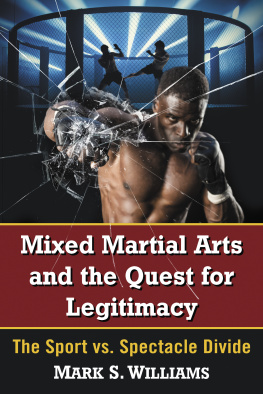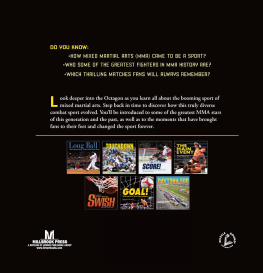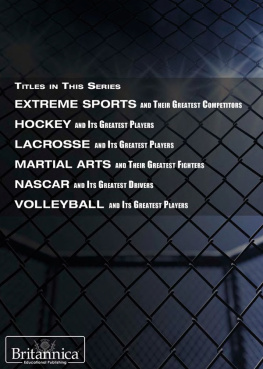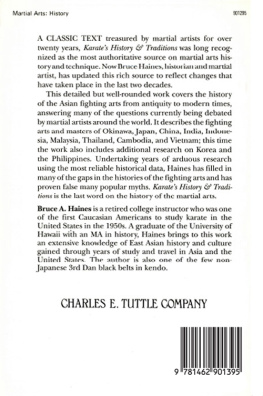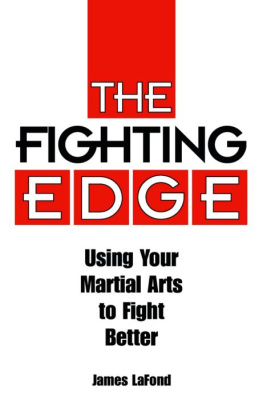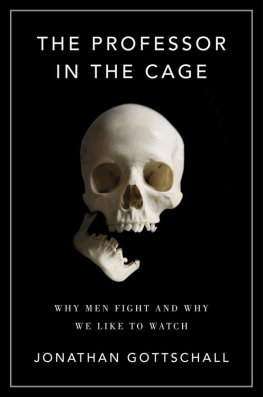BRAWL
BRAWL
A Behind-the-Scenes Look
at Mixed Martial Arts Competition
By Erich Krauss and Bret Aita

Copyright Erich Krauss and Bret Aita, 2002
Published by ECW PRESS
2120 Queen Street East, Suite 200, Toronto, Ontario, Canada M4E IE2
All rights reserved. No part of this publication may be reproduced, stored in a retrieval system, or transmitted in any form by any processelectronic, mechanical, photocopying, recording, or otherwisewithout the prior written permission of the copyright owners and
ECW PRESS.
NATIONAL LIBRARY OF CANADA CATALOGUING IN PUBLICATION DATA
Krauss, Erich, 1971
Brawl: a behind-the-scenes look at mixed martial arts competition / Erich Krauss
ISBN 978-1-55022-517-4
1. Martial artsCompetitions. I. Title.
GV1101.k73 2002 796.815 C2002-902199-5
Acquisition Editor: Emma McKay
Editor: Mary Williams
Design and typesetting: Yolande Martel
Production: Heather Bean
Printing: Transcontinental
Author photo: Andrew Krauss
Cover design: Guylaine Regimbald
Front cover photos: Susumo Nagoa (top); courtesy Dream Stage Entertainment (bottom left);
courtesy Zuffa Sports Entertainment (bottom middle and right)
Back cover photo: Andrew Krauss
This book is set in Janson and Argo.
Second Printing
DISTRIBUTION
CANADA: Jaguar Book Group, 100 Armstrong Avenue, Georgetown, Ontario L7G 5S4
UNITED STATES: Independent Publishers Group, North Franklin Street, Chicago, Illinois 60610
EUROPE: Turnaround Publisher Services, Unit , Olympia Trading Estate, Coburg Road, Wood Green, London N22 6T2
AUSTRALIA AND NEW ZEALAND: UNIREPS University of New South Wales, Sydney, NSW, Australia 2052
PRINTED AND BOUND IN CANADA

Contents
PART I
In the Beginning
PART II
The Apocalypse
PART III
Out of the Ashes
PART IV
New Warrior Class
Foreword
Erich Krauss is a young man full of adventure, loyalty, and love of the fighting game. When he wanted to learn about muay Thai, he went to Thailand by himself and trained and bled in the gym for almost half a year. He succeeded in his mission and went on to compete professionally in the arenas of Pataya, Thailand.
We have been friends for several years, and I have watched him continue to grow. He has become a great writer, as you will see. He has trained with me in mixed martial arts, so he knows the fight game from actual experience. He writes from the fighters point of view, he doesnt just describe things the way he thinks they should be, like so many other sports writers.
The sport of mixed martial arts is growing and will someday be a mainstay in the worlds sports diet. Right now, it is in the same position boxing was seventy-five years ago, and I think it will become even bigger than boxing as it encompasses all the phrases of single athletic competition. Not just standup or martial arts or even wrestlingyou have to be able to do it all.
Writers such as Erich, who research their material thoroughlynot only to tell of the fights, but also to tell the story of the fightersare a welcome addition to our sport. Good reading, and follow your dreams.
Bob Shamrock, father of legendary fighters Ken and
Frank Shamrock, and founder of Team Shamrock 2000
PART I
In the Beginning
CHAPTER 1
From the Arena to the Ring
Over two thousand years ago, in the dusty arena of the Greek Olympics, a hero named Arrachion engaged a dangerous competitor in no-holds-barred, hand-to-hand combat before a crowd of thousands. After a lengthy and brutal battle, Arrachion got caught in a crushing choke hold. His pride and valor would not let him submit, however, and even as he found himself fading to black he struggled to put his foe away. When nothing else presented itself, he seized his adversarys toe and wrenched it back. The pain made his opponent submit, but not soon enough. As the fighters were untangled, Arrachion was discovered to be dead, apparently of asphyxiationbut because his opponent had submitted first, the deceased Arrachion was declared the victor, and his memory has lived on through the ages.
For thousands of years, soldiers have tested their hand-to-hand combat skills in war, transforming their bodies into effective and deadly weapons. Although there were those who survived to become heroes, the bloodstained battlefield was a harsh proving ground, and eventually the ways of war were turned into sport so combatants could test their skills and live to tell the tale. The participants in these man-to-man spectacles were limited to the brave, and a new kind of hero was born. Spectators clamored by the thousands to behold them in action. Images of broken arms, knees to the face, and powerful choke holds spawned daydreams of competition, victory, and glory.
Even in our modern technological world, where battles are won with the touch of a button or the pull of a trigger, the need to experience the rush of hand-to-hand combat persists in both warriors and their fans. In Brazil, they call these competitions vale tudo. In Japan, its called submission fighting. It sprang up in the United States as no-holds-barred and was later dubbed mixed martial arts. Whether combatants battle it out in cages, rings, back alleys, or warehouses, their reasons are usually the same: to discover what works and what doesnt, to test their personal limits, and to answer the age-old question, Who is the toughest?
This anything-goes style of hand-to-hand competition is documented as early as 648 BC with the introduction of pankration, a combination of boxing and wrestling, into the Greek Olympics. Pankration means all-powers, or all-in-combat, and it originated when fighters in both boxing and wrestling began refining their skills, seeking a new level of competition. This is not to say that these individual sports werent already vicious. Boxers, unlike todays pugilists, were allowed to punch their opponents unmercifully while they were on the ground. Wrestlers learned various joint manipulations to inflict as much pain upon their opponents as possible. In both boxing and wrestling, there were no time limits, no rounds, and no weight classes. The bouts were decided when a fighter either submitted or was rendered incapable of continuing the match.
The pankratiasts of yore took man-to-man combat one step further. They synthesized the techniques of the boxers strikes and the wrestlers groundwork into a lethal and individualistic fighting style. The only rules in pankration were no biting and no gouging of the eyes, and the matches were often brutal. Many ended with the champion being permanently disabled and the loser dying. On the upside, however, there was immeasurable glory and honor involved. The victors of these games were treated like mythical heroes, their lives and deeds depicted on pottery and immortalized in stone carvings.
Tales of pankration champions are shrouded in legend and poetic license. One story is of the charismatic Milo of Crotona, who achieved a level of popularity comparable to that of modern-day martial artist Bruce Lee. He engaged in all sorts of public displays of skill, and it was rumored that Milo built up his unusual strength by lugging a calf on his back every day until it became a bull. Stories recount how Milo would tie a cord around his head and hold his breath, creating such a rush of blood to his skull that the pressure would snap the cord.
Next page

